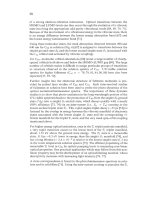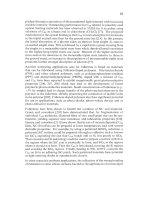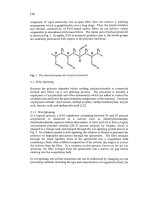Carbon Materials for Advanced Technologies Part 12 ppsx

Carbon Materials for Advanced Technologies Part 12 ppsx
... for the second cycle of lithdcarbon electrochemical cells made from OXY, a representatwe hard carbon, and those for samples made from CRO, a representative soft carbon. 393 I. 4 Particle/matter ... understanding of carbons for Li-ion batteries have been made in the last 5 to 10 years. If continued progress is made, we can expect to see carbon materials in Li-ion...
Ngày tải lên: 10/08/2014, 11:21

Carbon Materials for Advanced Technologies Part 9 ppsx
... All commercial carbons have been made for uses other than natural gas storage. They are for the most part granular materials and pack into vessels with a substantial inter-particle void volume ... which is necessary for 170 VIV storage. Table 2. Fractional Volume Composihon of Carbon Particle for some Commercial Carbons Hg Porosimetry Fractional Volume of Carbon...
Ngày tải lên: 10/08/2014, 11:21

Carbon Materials for Advanced Technologies Part 1 pdf
... Introduction 1 2 Crystalline Forms of Carbon 3 3 The Phase and Transition Diagram for Carbon 12 4 CarbonFilms 14 5 Carbon Nanoparticles 18 6 Engineering Carbons 20 7 ConcludingRemarks ... molecule is named. In the C, molecule each carbon atom is bonded to three Carbon Materials for Advanced Technologies vi 4 High Performance Carbon F...
Ngày tải lên: 10/08/2014, 11:21

Carbon Materials for Advanced Technologies Part 3 potx
... only a small number of carbon atoms, and because of their large aspect ratio, carbon nanotubes are classified as 1D carbon systems. Most of the theoretical work on carbon nanotubes has been ... band is smaller for semiconducting nanotubes and larger for metallic nanotubes, and that the density of states at the Fermi level is non-zero for metallic nanotubes, but zero for...
Ngày tải lên: 10/08/2014, 11:21

Carbon Materials for Advanced Technologies Part 4 ppt
... B48,8 412( 1993). 98 7 carbon materials i active carbons active carbon fibers Fig. 1. Venn diagram illustrating where active carbon fibers lie in the classification of carbon materials. ... fibres, Carbon, 1997, 35(2), 291 297. Cook, T. L., Komodromos, C., Quinn, D. F. and Ragan, S., Adsorbent storage for natural gas vehicles. In Carbon Materials for...
Ngày tải lên: 10/08/2014, 11:21

Carbon Materials for Advanced Technologies Part 5 doc
... commercial carbon fibers (adapted from W1). 6 Current Areas for High Performance Carbon Fiber Research Much of the current interest surrounding high performance carbon surrounds their potential for ... crystallinity during carbonization, in contrast to current carbon fibers produced from PAN. 3.1 Mesophase Formation The mesophase pitches used for high-modulus carbon f...
Ngày tải lên: 10/08/2014, 11:21

Carbon Materials for Advanced Technologies Part 6 pot
... (ORNL) for an aerospace application. Porous, carbon fiber -carbon binder composite materials are a class of carbon composites that are not widely recognized. Unlike dense, structural carbon- carbon ... Vapor-grown carbon- fiber reinforced carbon composites, Carbon, 1995,33(5), 663 667 LI. Lake, M.L. Ting, J M. and Corrigan, M., Carbodcarbon composites for space 159...
Ngày tải lên: 10/08/2014, 11:21

Carbon Materials for Advanced Technologies Part 7 pptx
... pitches for binders and feedstocks for cokes [12] . Indeed, the majority of organic chermcals and carbonaceous materials prior to World War I1 were based on coal technologies. Unfortunately, ... fabricahon of coke, carbon, and artlficial graphite [ 11. These same feedstocks also have the potential for use in producing " ;advanced& quot; carbon products such as carb...
Ngày tải lên: 10/08/2014, 11:21

Carbon Materials for Advanced Technologies Part 8 pdf
... lighter weight carbon canister to be packaged on the vehicle. 5.1.2 Carbon particle size The second carbon characteristic affecting performance of carbon canisters is the carbon particle size. ... activated carbon bed has adsorbed about 65 grams of HC. 234 6. 7. 8. 9. 10. 11. 12. 13. 14. 15. 16. 17. 18. 19. 20. 21. 22. feedstocks. Paper presented at Car...
Ngày tải lên: 10/08/2014, 11:21

Carbon Materials for Advanced Technologies Part 10 pps
... the C2-C4 hydrocarbons and would displace them over a number of cycles. It is apparent therefore that the C5 plus hydrocarbons must be considered the primary target gases for pre-adsorption ... range of suitable materials available and the ability to engineer them for a particular application. The number of liquid absorbent - refrigerant pairs that give reasonable performance...
Ngày tải lên: 10/08/2014, 11:21